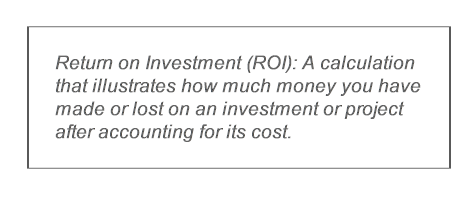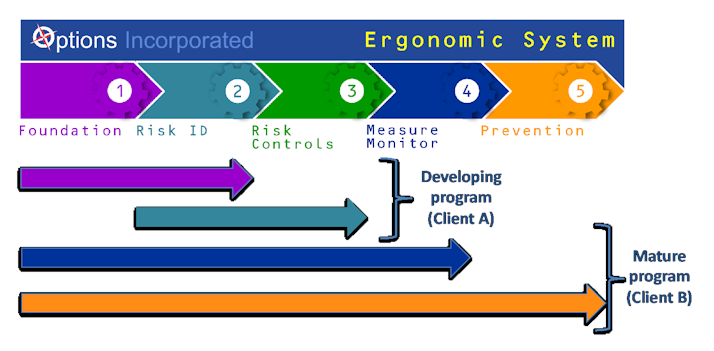Ergonomics and Change Management: Measuring the Value of Ergonomics Through Client ROI
Written by: Hayley LaPier, AE, Ergonomic Consultant

For many organizations, the value of ergonomics interventions is assessed within the context of the levels of productivity, or in calculating injury costs before, and injury costs after. This insight confirms the need and importance for practitioners to quantify the impact an ergonomic change has, as well as, to understand how to align any gains with broader corporate goals and key performance indicators (KPIs). The challenge is, how can practitioners correlate ergonomic outcomes across clients that have varying levels of programs and systems?

To illustrate how this could be completed, we have highlighted scenarios from two of our clients where we analyzed programs and identified data points to consider their ergonomics solutions against Return on Investment (ROI) metrics.
The first client (Client A) was in earlier stages of implementing an ergonomics program and the second client (Client B) had an established program, supported by policies, procedures, measures, controls and data collected to assess impact.
At both clients we worked to identify the ROI using the below accepted formula.
Our scenario at Client A included investigating the 4-year rate of return on implementing a height-adjustable bench. The scenario at Client B included exploring the 2-and 5-year rates of return associated with installing a height-adjustable floor.

Findings:
- Client A: Provided data included; the number of injuries, restricted work days and employee wages. Additional required data (e.g. cost of injuries) was not available and as such was extrapolated from provincial data. Using the calculation listed above and inputting available data, the 4-year rate of return on one bench was calculated to be 164%, or for every dollar spent on this intervention, the organization would see a potential return of $1.64. For two benches, the rate of return shifted to 31%, or for every dollar spent, the organization would see a potential return of $.31.
REFLECTION: Even with gaps in injury data management, calculating a ROI was achievable with the use of industry accepted data sources and extrapolation methods. - Client B: Provided data included; the number of injuries, restricted/lost work days, employee wages, internal health services costs, and WSIB costs. Client specific cost of injuries was calculated from client historical data, with consideration of details on type of injury and productivity inputs. The 2-year rate of return on the flooring intervention was calculated at -46%, or for every dollar spent on this intervention, the organization would see a potential return of ($.46). In 5-years, the rate of return shifts to 35%, or $.35 for every dollar spent.
REFLECTION: Advanced client tracking and internal systems may still require additional data analytics to interpret data sources and support calculating an accurate ROI.
As shown in these scenarios, regardless of the current state of an organizations data management and tracking system, metrics and ROI values can be identified and calculated. Each scenario requires an analytical and curious eye to identify data sources and determine methods to best move forward to provide clients with relevant metrics. As ergonomics professionals we need to continually work to understand organization/client priorities and business methods (ie. considering ROI) to ensure our solutions are considered in the same manner as quality and productivity driven changes.
Feel free to contact us to discuss how we can help you identify methods of introducing or enhancing consideration of return on investment (ROI) as well as other cost benefit analysis metrics to your organization.
References:
Gartley, R. M., & Prosser, J. L. (2011). Stretching to prevent musculoskeletal injuries. An approach to workplace wellness. AAOHN Journal, 59(6), 247–252.
Institute for Work and Health. (2022). Estimating the financial benefits of OHS prevention expenditures: a study of Ontario employers.
Ontario Safety Group. Understanding the ROI of Health and Safety. https://osg.ca/understanding-the-roi-of-health-and-safety/
Safety Management Group. Injury Cost Calculator. https://safetymanagementgroup.com/injury-%20cost-calculator/
Washing State Department of Labor & Industries, Puget Sound Human Factors and Ergonomics Society, Potvin, Ergonomics Cost Benefit Analysis Summary of Case Studies
Weltman, Barbara. (2019). How Much Does an Employee Cost you? U.S. Small Business Administration. https://www.sba.gov/blog/how-much-does-employee-cost-you
WorksafeBC (2016). Workplace Incident Cost Calculator. https://www.worksafebc.com/en/resources/health-safety/interactive-tools/workplace-incident-cost-calculator?lang=en
Contact Us Back to Articles
